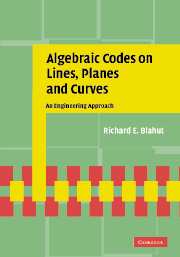Book contents
- Frontmatter
- Contents
- List of figures
- List of tables
- Preface
- Dedication
- 1 Sequences and the One-Dimensional Fourier Transform
- 2 The Fourier Transform and Cyclic Codes
- 3 The Many Decoding Algorithms for Reed–Solomon Codes
- 4 Within or Beyond the Packing Radius
- 5 Arrays and the Two-Dimensional Fourier Transform
- 6 The Fourier Transform and Bicyclic Codes
- 7 Arrays and the Algebra of Bivariate Polynomials
- 8 Computation of Minimal Bases
- 9 Curves, Surfaces, and Vector Spaces
- 10 Codes on Curves and Surfaces
- 11 Other Representations of Codes on Curves
- 12 The Many Decoding Algorithms for Codes on Curves
- Bibliography
- Index
3 - The Many Decoding Algorithms for Reed–Solomon Codes
Published online by Cambridge University Press: 05 October 2009
- Frontmatter
- Contents
- List of figures
- List of tables
- Preface
- Dedication
- 1 Sequences and the One-Dimensional Fourier Transform
- 2 The Fourier Transform and Cyclic Codes
- 3 The Many Decoding Algorithms for Reed–Solomon Codes
- 4 Within or Beyond the Packing Radius
- 5 Arrays and the Two-Dimensional Fourier Transform
- 6 The Fourier Transform and Bicyclic Codes
- 7 Arrays and the Algebra of Bivariate Polynomials
- 8 Computation of Minimal Bases
- 9 Curves, Surfaces, and Vector Spaces
- 10 Codes on Curves and Surfaces
- 11 Other Representations of Codes on Curves
- 12 The Many Decoding Algorithms for Codes on Curves
- Bibliography
- Index
Summary
Decoding large linear codes, in general, is a formidable task. For this reason, the existence of a practical decoding algorithm for a code can be a significant factor in selecting a code. Reed–Solomon codes – and other cyclic codes – have a distance structure that is closely related to the properties of the Fourier transform. Accordingly, many good decoding algorithms for Reed–Solomon codes are based on the Fourier transform.
The algorithms described in this chapter form the class of decoding algorithms known as “locator decoding algorithms”. This is the richest, the most interesting, and the most important class of algebraic decoding algorithms. The algorithms for locator decoding are quite sophisticated and mathematically interesting. The appeal of locator decoding is that a certain seemingly formidable nonlinear problem is decomposed into a linear problem and a well structured and straightforward nonlinear problem. Within the general class of locator decoding algorithms, there are many options, and a variety of algorithms exist.
Locator decoding can be used whenever the defining set of a cyclic code is a set of consecutive zeros. It uses this set of consecutive zeros to decode, and so the behavior of locator decoding is closely related to the BCH bound rather than to the actual minimum distance. Locator decoding, by itself, reaches the BCH radius, which is the largest integer smaller than half of the BCH bound, but reaches the packing radius of the code only if the packing radius is equal to the BCH radius.
- Type
- Chapter
- Information
- Algebraic Codes on Lines, Planes, and CurvesAn Engineering Approach, pp. 137 - 189Publisher: Cambridge University PressPrint publication year: 2008



